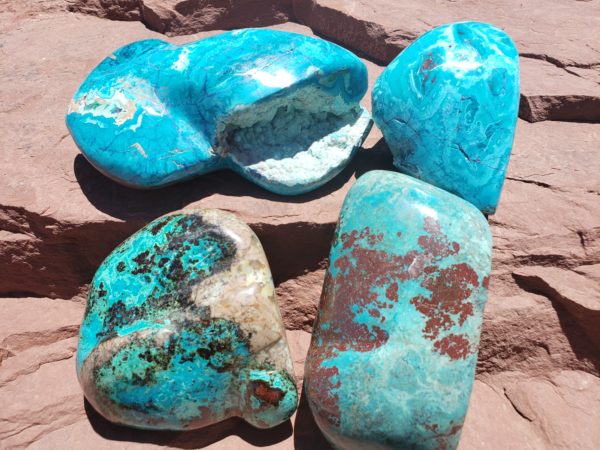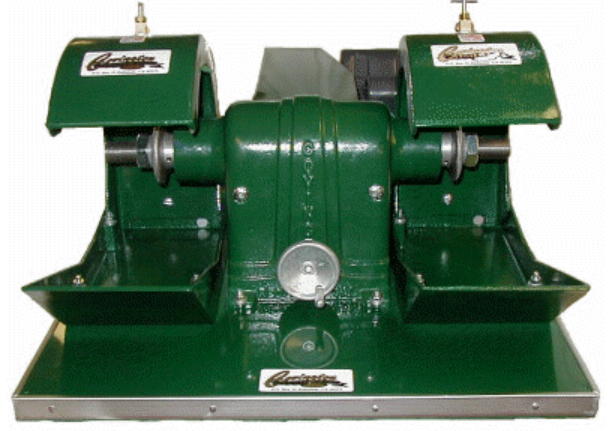What Kind of Mineral is Chrysocolla?
Chrysocolla is a secondary hydrated copper phyllo-silicate mineral. It’s chemical formula is CuSiO3·2H2O.
Color and Appearance of Chrysocolla
Chrysocolla color varies from a light sky blue to a rich blueish green. It is often mistaken for turquoise due to its color. This stone can exhibit a wide range of lustrous appearances, from dull and waxy to vitreous which means glassy . Chrysocolla can also appear translucent or opaque, depending on the type of material.
How is Chrysocolla Formed?
Chrysocolla forms in the upper sections of pockets (oxidation zones) that are rich in copper ore. Its formation is due to chrysocolla being a decomposition product of copper minerals in copper mines, especially if the mines are located in dry areas. This mineral is amorphous meaning that it does not have a coherent crystalline structure. However, at higher temperatures it does demonstrate a distorted crystal structure. Chrysocolla is found in massive forms such as crusts and stalactites as well as botryoidal form. This stone can form as inclusions in other minerals such as quartz also. When It does occur as crusts or masses, it usually forms in the upper parts of copper ore veins where the copper minerals have been altered by water containing dissolved silica.
Chrysocolla is a copper silicate made up of oxygen, copper, silica, aluminum and hydrogen. This combination of different materials occurs during formation. Chrysocolla is a secondary mineral of copper, meaning it was formed when copper minerals were changed by other chemicals. This usually happens when water containing carbon dioxide seeps through the copper, leaching the various chemicals until they gather in cracks and fissures and then harden. This basic material is usually composed of a combination with other minerals such as quartz, chalcedony, azurite, cuprite, and malachite. Pure chrysocolla is considered to be a relatively soft mineral. The hardness for chrysocolla is 2.5 to 5.0. on the Mohs scale .
Chrysocolla Localities

Chrysocolla is mainly found in dry areas like the Southwest areas of the United States. It is a copper bearing mineral found wherever copper deposits occur. Notable localities of chrysocolla include the United States, particularly Arizona. Famous copper mines where spectacular specimens of chrysocolla have been found include: Morenci, Inspiration, Baghdad, and Bisbee Mines. Other American chrysocolla localities include: Utah, New Mexico, Michigan, and Pennsylvania. Other notable chrysocolla locations in the world include; Mexico, Peru, Chile, Democratic Republic of Congo (Zaire), Australia, Russia, Cornwall in England, France, and Israel.
History of Chrysocolla

The first well known account of the chrysocolla name being used, was recorded in 315 BC, by a Greek botanist and philosopher named Theophrastus. The word “chrysocolla” was derived from the Greek words “chrysos”, meaning gold, and “kola”, meaning glue. Chrysocolla resembles borax which was used as a flux for soldering gold in ancient times.
Chrysocolla has been used by humans for thousands of years. Its earliest known source was the copper mines of southern Israel near present day Eilat in the Gulf of Aqaba. Chrysocolla has also been historically referred to as King Solomon Stone after the famous ruler of Ancient Israel. Most likely, the earliest chrysocolla came from the lost King Solomon’s Mines. The location of the lost mines is still up for debate. The famous English Victorian novel, King Solomon’s Mines, written in 1885 by author H. Rider Haggard, places the lost mines in a then unexplored area of Africa. This belief changed when newer evidence was provided by an American archaeologist Nelson Glueck, who explored Israel in the 1930’s. He believed the famous mines were located in the Great Rift Valley on the border of Israel and Jordan. Popular opinion of the lost mines location changed yet again. Modern archaeologists discovered newer evidence that suggests the lost mines of King Solomon are actually located within the extensive copper mines of Timna Valley in the southern tip of Israel. Carbon dated evidence suggests that this ancient site was once a vast copper mining operation dating back to the 10th century B.C. which coincides with the time of King Solomon’s rule.
Chrysocolla Included Copper Secondary Mineral Combinations

Chrysocolla itself is a copper silicate and is considered to be an unusual material. Some would go so far as to argue that chrysocolla is not really a mineral at all, but rather a silica gel hardened over time. Chrysocolla is often formed with other copper secondary minerals such as cuprite, azurite , malachite, shattuckite, and tenorite. The interesting color combinations of the copper secondary minerals create striking patterns made of beautiful blue, green, red and black tones. Chrysocolla can also grow with other minerals like chalcedony and quartz, which make the chrysocolla hard enough to be used as a gemstone.
Chrysocolla Varieties Include:
Eilat Stone – A vivid blue and green combination stone that is made up of copper secondary minerals including: azurite, chrysocolla, malachite, and turquoise. It is still mined in Eilat Israel where some of the oldest copper mines in the world are located. Eilat stone is considered to be a very special and sacred stone of the land there. For this reason, it is known as Israel’s national stone.
Parrot Wing/Parrot Wing Chrysocolla – A striking copper secondary stone, mined in Mexico with a mixture of chrysocolla, jasper, azurite, and quartz. The color of parrot wing chrysocolla is made up of bright lime green and sky blue hues as well as rich brown and red tones.
Sonoran Sunrise/ Sonoran Sunset – A red, black, and green copper secondary stone mined in Mexico. It is mainly made of cuprite (red) and tenorite (black). The green mineral in this stone, however, is up for debate. Some say it’s chrysocolla or malachite while others say it’s brocentite.
Gem Silica/ Chrysocolla Chalcedony – This gorgeous transparent gemstone is very rare and highly valuable which makes it well sought after. Gem silica is composed of micro-crystalline quartz (chalcedony) that has been stained with chrysocolla. The mere stain of the copper ore mineral chrysocolla is enough to turn the chalcedony into a beautiful aqua blue-green stone that light can still pass through.
Quantum Quattro is a rare, blue and green stone that has only been found in Namibia, Africa. This colorful copper secondary combination includes: chrysocolla, malachite, shattuckite, dioptase, and quartz.
Chrysocolla Druzy – This stone has sparkly layers of very small quartz crystals called druzy forming on the top of agatized chrysocolla. These beautiful, little sea-blue crystals are plentiful. The most recent “find” of chrysocolla druzy is located in Chile.
Metaphysical Properties Of Chrysocolla

Chrysocolla is most well known as a communication stone. It is a teaching stone that will help communicate the right words either one needs to say and/or hear at any given moment. It is also a motivation stone that helps captivate an audience. It inspires one to have the courage to speak out about important issues. Chrysocolla also has the uncanny ability to help assist individuals convey inspiring messages to those who need to hear it the most when it is needed the most. A Fun Fact: It is said that Cleopatra carried chrysocolla with her at all times to stay balanced and focused when speaking with others.
Lapidary Tips – Working with Chrysocolla

Pure chrysocolla is considered to be soft and chalky making it too fragile to work with, because it can scratch so easily. Most chrysocolla, used for jewelry purposes, is material that is hard enough to polish for cabochons. Some examples of good chrysocolla lapidary material are: chrysocolla has either been agitated in chalcedony or quartz; mixed with other copper secondary minerals; or fracture sealed with a product like Opticon. Chrysocolla can also be stabilized by other means. (If you are interested in reading more about the stabilization process for softer copper minerals like chrysocolla and turquoise, click this blue stabilized link.) Chrysocolla druzy can also be cut into cabochons and used in jewelry. Stones that are cut and polished from chrysocolla are best used in pendants and earrings, which are less likely to knock against something and break. Another important thing to keep in mind about chrysocolla, is that it’s a soft mineral and therefore very sensitive to water. When working with it, do not leave it sitting in water for long periods of time. Chrysocolla cuts well using both standard diamond wheels as well as cerium oxide belts. Polishing with diamond and green rouge (zam) will work wonders when polishing softer copper minerals, like chrysocolla.
Chrysocolla is for sale on our www.coppercanyonlapidary.com and www.colorwright.com websites – Looking for chysocolla for your next project? Please feel free to look through the chrysocolla we have available , by browsing our website using the blue links below:
We have quite a bit of Chrysocolla Rough available on the great rough website. This includes regular chrysocolla rough http://www.greatrough.com/rough_chrysocolla.shtml ; chrysocolla in quartz http://www.greatrough.com/rough_chrysocolla_in_quartz.shtml ; Gem Silica http://www.greatrough.com/rough_chrysocolla_gem_silica.shtml ; Sonoran Sunrise http://www.greatrough.com/rough_cuprite_chrysocolla_sonoran-sunrise.shtml ;
Sonoran Sunrise Slabs http://www.greatslabs.com/slabs_chrysocolla_sonoran_sunrise.shtml
Lastly, we have Chrysocolla Finished Cabochons – Sonoran Sunrise Cabochons: Cabochons Gallery 160: Sonoran Sunrise Chrysocolla Cabochons ; Sale Cabochons Gallery 2: Sonoran Sunrise Chrysocolla Cabochons ;Cabochons Gallery 32: Sonoran Sunrise Chrysocolla Cabochons ; Sale Cabochons Gallery 5: Chrysocolla, Sonoran Sunrise Chrysocolla Cabochons Parrot Wing Chrysocolla Cabochons Gallery 69: Chrysocolla and Malachite, Parrot Wing Chrysocolla Cabochons ; Cabochons Gallery 1: Chrysocolla with Malachite, Chrysocolla Cabochons ; Chrysocolla Gem Silica Cabochons Cabochons Gallery 94: Chrysocolla, Gem Silica Cabochons
Chrysocolla is an incredibly beautiful and vibrant copper silicate mineral. It has been used in sculpture and jewelry throughout history. This ancient stone has always been highly valued and continues to be well loved and known for it’s vivid color, unique properties, and versatility.
